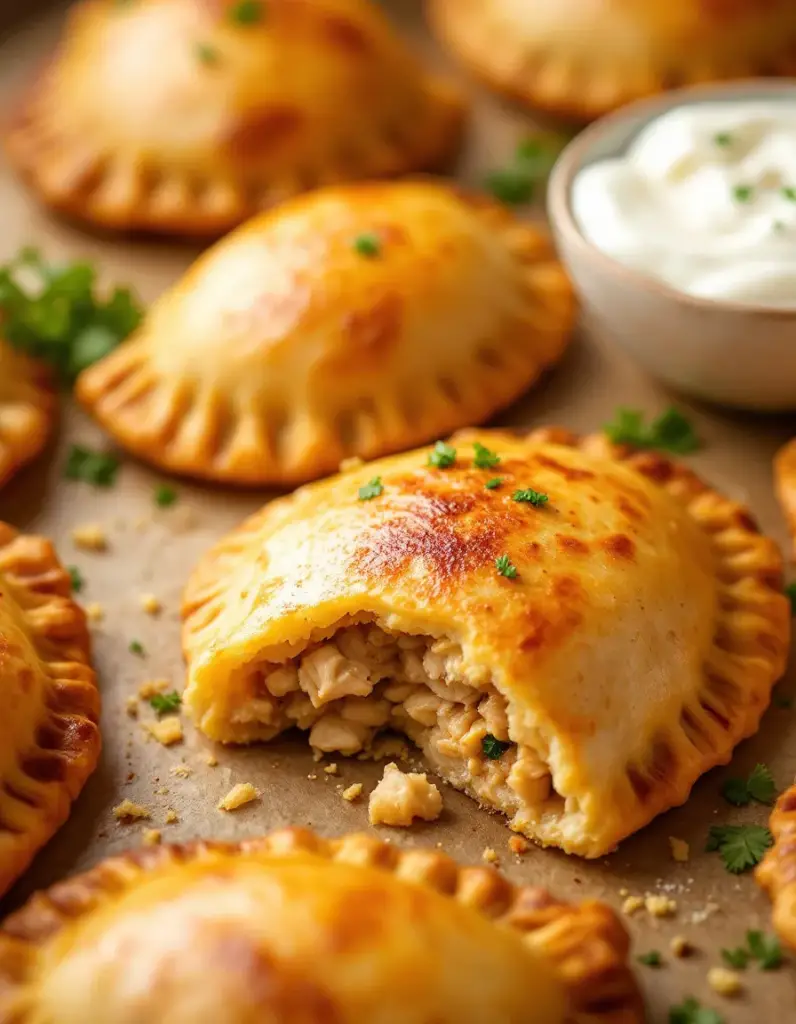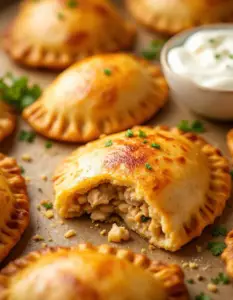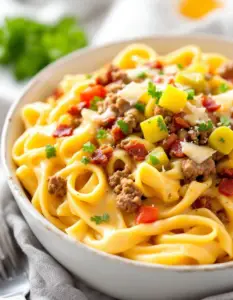Baked Chicken Empanadas: Crispy, Flaky Handheld Delights
These baked chicken empanadas are the perfect combination of crispy, golden-brown pastry and savory, well-seasoned chicken filling. Whether you’re looking for a crowd-pleasing appetizer, a portable lunch option, or a satisfying snack, these Latin-inspired hand pies deliver incredible flavor in every bite. The flaky crust gives way to a moist, aromatic chicken mixture infused with traditional spices, making these empanadas irresistible.
What makes these baked chicken empanadas special is their versatility. They can be enjoyed hot from the oven or at room temperature, making them ideal for meal prep, parties, or on-the-go eating. The baking method creates a lighter alternative to traditional fried versions while still achieving that satisfying crunch. The filling can be customized to your taste preferences, allowing you to create your perfect version of this classic dish.
Quick Recipe Highlights
- Flavor Profile: These empanadas feature a savory blend of shredded chicken, onions, garlic, and Latin spices with a hint of sweetness from raisins and olives.
- Texture: The contrast between the crisp, buttery pastry exterior and the tender, juicy chicken filling creates an irresistible mouthfeel.
- Aroma: As they bake, your kitchen will fill with the warm scents of cumin, paprika, and golden-brown pastry.
- Visual Appeal: The golden-brown crescents with crimped edges make these empanadas as beautiful as they are delicious.
- Skill Level Needed: While some pastry experience helps, this recipe includes detailed instructions for first-time empanada makers.
- Special Equipment: You’ll need a rolling pin, baking sheets, and a pastry brush for egg wash application.
Recipe Overview
- Difficulty Level: This recipe earns its intermediate rating due to the pastry handling and shaping techniques required, but detailed instructions make it accessible.
- Category: Perfect as appetizers, snacks, or light meals – these empanadas fit multiple dining occasions.
- Cuisine: Rooted in Latin American traditions with Spanish influences, these empanadas represent a delicious fusion of cultures.
- Cost: Budget-friendly at approximately $1.25 per empanada, using common pantry ingredients and affordable chicken.
- Season: Excellent year-round, but particularly satisfying during cooler months when warm, savory pastries are most comforting.
- Occasion: Ideal for game day, potlucks, picnics, or as make-ahead freezer meals for busy weeknights.
Why You’ll Love This Baked Chicken Empanadas Recipe
The first bite of these baked chicken empanadas delivers an irresistible combination of textures and flavors. The golden-brown pastry shatters delicately to reveal a perfectly seasoned chicken filling that’s moist but not wet, packed with savory depth from onions, garlic, and traditional Latin spices. Unlike fried versions, these baked empanadas offer all the satisfaction without the greasiness, making them a lighter yet equally delicious alternative.
Preparation benefits make this recipe a keeper. The dough comes together quickly in a food processor, and the filling can be made ahead or repurposed from leftover chicken. These empanadas freeze beautifully before or after baking, giving you ready-to-eat homemade snacks whenever cravings strike. The assembly process becomes therapeutic once you get the hang of it, and the impressive results belie the relatively simple techniques involved.
Nutritionally, these baked chicken empanadas offer a balanced package. The chicken provides lean protein, while the whole wheat pastry option adds fiber. Baking instead of frying significantly reduces fat content without sacrificing texture or flavor. Portion-controlled by nature, each empanada makes a satisfying snack or light meal component that’s easy to fit into various dietary approaches.
For entertaining, few dishes rival the universal appeal of these empanadas. They’re equally at home at casual gatherings and more formal parties, always disappearing quickly from serving platters. Their handheld nature makes them perfect for mingling guests, and their sturdy construction holds up well on buffet tables. The beautiful presentation requires minimal garnishing – just a simple sprinkle of chopped parsley or cilantro adds a fresh pop of color.
Cost-effectiveness makes this recipe particularly appealing. Using economical chicken thighs or repurposing leftover rotisserie chicken keeps the budget in check, while the pastry ingredients are basic pantry staples. A single batch yields a dozen generous empanadas, stretching your protein further than many other preparations. The freezer-friendly nature means you can make the most of sales or bulk purchases without waste.
Historical Background and Cultural Significance
The empanada traces its roots to Spain, where the concept of wrapping meat in dough dates back to medieval times. The name comes from the Spanish verb “empanar,” meaning to wrap or coat in bread. As Spanish colonists brought their culinary traditions to Latin America, the empanada evolved with local ingredients and flavors, becoming a staple across the region. Today, every Latin American country has its signature version, with variations in dough, fillings, and cooking methods.
In many Latin cultures, empanadas hold significant social importance. They’re traditional party food, often served at celebrations and family gatherings. The process of making empanadas frequently becomes a communal activity, with multiple generations working together to fill and fold the pastries. This shared cooking experience reinforces family bonds and passes down culinary traditions. The portable nature of empanadas also made them practical meals for workers and travelers throughout history.
The evolution of the chicken empanada reflects the fusion of indigenous and colonial influences. While early Spanish versions used beef or pork, chicken became prominent in areas where poultry was more readily available. The addition of ingredients like olives, raisins, and hard-boiled eggs varies by region, with each country and even individual families developing their signature touches. The baked versus fried preparation often depends on local customs and resource availability.
Regional variations showcase the diversity of Latin American cuisine. Argentine empanadas typically feature a flakier pastry and distinct half-moon crimping style. Colombian versions often include potatoes in the filling and are slightly sweeter. Puerto Rican empanadas frequently use a plantain-based dough for a gluten-free alternative. Despite these differences, the fundamental appeal remains constant – a delicious, self-contained meal that’s as practical as it is flavorful.
Ingredient Deep Dive
Chicken Thighs
Chicken thighs form the foundation of our empanada filling, offering several advantages over breast meat. Their higher fat content keeps the filling moist during baking and provides richer flavor. Thighs also withstand longer cooking times better than breasts, making them more forgiving if your empanadas stay in the oven a few extra minutes. Nutritionally, thighs provide iron, zinc, and B vitamins in addition to quality protein.
When selecting chicken thighs, look for plump pieces with pinkish flesh and minimal visible fat. Skin-on thighs will yield the most flavorful meat, though you can remove the skin before cooking if preferred. For the quickest preparation, purchase boneless, skinless thighs. Store raw chicken in the coldest part of your refrigerator and use within 1-2 days, or freeze for longer storage. Cooked chicken filling keeps well for 3-4 days refrigerated.
Empanada Dough
The dough for baked chicken empanadas differs from pie crust in its slightly sturdier structure, designed to contain moist fillings without becoming soggy. Traditional recipes use wheat flour, though gluten-free alternatives work well too. The inclusion of egg adds richness and helps with browning, while vinegar tenderizes the gluten for a more delicate texture. Some versions incorporate butter for flavor, while others use lard or vegetable shortening.
For best results, use cold ingredients and handle the dough minimally to prevent toughness. The dough should rest before rolling to relax the gluten. If you’re short on time, quality store-bought empanada discs or even pie crust can substitute in a pinch. Dough can be made ahead and refrigerated for 2 days or frozen for 2 months – just thaw overnight in the refrigerator before using.
Latin Spice Blend
The characteristic flavor of these empanadas comes from a balanced blend of cumin, paprika, and oregano. Cumin provides earthy warmth, while paprika adds subtle sweetness and color. Oregano contributes herbal notes that complement the chicken beautifully. Together, these spices create the distinctive flavor profile associated with Latin American cuisine. For authentic taste, use high-quality, fresh spices – their volatile oils diminish over time.
Beyond the basic trio, many cooks add personal touches like a pinch of cinnamon for depth or chili powder for heat. The spices bloom when cooked with the onions and garlic, releasing their full aromatic potential. Store spices in airtight containers away from heat and light to preserve potency. For those watching sodium, the spice blend provides ample flavor without excessive salt.
Common Mistakes to Avoid
- Overfilling the empanadas: This leads to bursting during baking. Use about 2 tablespoons of filling per 5-inch dough circle, leaving adequate border space for sealing.
- Wet filling: Excess moisture makes the pastry soggy. Thoroughly drain cooked ingredients and consider adding breadcrumbs to absorb liquid.
- Inadequate sealing: Poorly crimped edges allow filling to leak. Use the fork or fold method shown in our instructions, and chill before baking to help seals set.
- Rolling dough too thin: Aim for 1/8-inch thickness – too thin and it tears; too thick and it bakes up doughy rather than flaky.
- Skipping the egg wash: This crucial step ensures beautiful browning. For extra shine, use whole egg rather than just egg white.
- Overworking the dough: Excessive handling develops gluten, resulting in tough pastry. Mix just until combined and handle gently when rolling.
- Baking at wrong temperature: 375°F-400°F is ideal – too low and the pastry becomes greasy; too high and it browns before the filling heats through.
- Not venting the tops: Cutting small slits allows steam to escape, preventing soggy bottoms and burst seams.
Essential Techniques
Dough Handling
Proper dough handling makes the difference between tough and tender pastry. Keep all ingredients cold, especially the fat (butter or shortening), to create flaky layers. When mixing, pulse just until the dough comes together – overworking develops gluten. Let the dough rest before rolling to relax the gluten strands. When rolling, work quickly to prevent the fat from melting, and use just enough flour to prevent sticking without drying out the dough.
Filling Preparation
The filling should be flavorful but not wet. Cook down onions and other vegetables until most of their moisture evaporates. Shred the chicken finely so it distributes evenly and doesn’t poke through the dough. Cool the filling completely before assembling – warm filling melts the fat in the dough, making it harder to work with and potentially causing sogginess. If the filling seems too moist, add breadcrumbs or crushed crackers to absorb excess liquid.
Crimping Methods
Proper sealing prevents leaks during baking. The fork method (pressing tines around the edge) is simplest for beginners. The repulgue technique (folding and twisting the edge) creates the traditional rope-like border but requires practice. Whichever method you choose, ensure no filling gets caught in the seal. For extra security, brush the edges with water or egg wash before sealing. Chilling the assembled empanadas for 30 minutes before baking helps the seals set.
Pro Tips for Perfect Baked Chicken Empanadas
- For extra flaky layers, fold the rolled-out dough like a letter and roll again before cutting circles.
- Add a teaspoon of vinegar to the dough to inhibit gluten development and keep it tender.
- Use an ice cream scoop to portion filling consistently and keep edges clean for sealing.
- If dough becomes too soft while working, chill it for 15 minutes before continuing.
- For even browning, rotate baking sheets halfway through cooking time.
- Let baked empanadas rest 5 minutes before serving – the filling will be extremely hot.
- For shiny tops, brush with egg wash twice – once before baking and again halfway through.
- Add a pinch of sugar to the egg wash for deeper golden color.
Variations and Adaptations
Regional Variations
Argentinian versions often include hard-boiled eggs and green olives in the filling. Colombian chicken empanadas might feature potatoes and a touch of achiote for color. Puerto Rican cooks sometimes add sofrito and capers for bright flavor. Mexican variations could incorporate chipotle peppers or queso fresco. Each region’s unique take offers inspiration for customizing your perfect empanada.
Dietary Modifications
For gluten-free empanadas, use a blend of rice flour, tapioca starch, and xanthan gum. Dairy-free versions substitute vegetable shortening or coconut oil for butter. Vegan adaptations might use shredded jackfruit or mushrooms instead of chicken. Low-carb alternatives employ almond flour dough or wrap the filling in lettuce leaves for a deconstructed version.
Flavor Twists
For a smoky variation, add roasted red peppers or chipotle powder to the filling. Mediterranean-inspired versions could include feta cheese and sun-dried tomatoes. Asian fusion might feature ginger, soy sauce, and shiitake mushrooms. Sweet-savory combinations with apples and sage offer autumnal appeal. The basic technique accommodates endless creative interpretations.
Serving and Presentation Guide
Presentation elevates these baked chicken empanadas from simple snack to impressive offering. Arrange them on a wooden board or colorful platter with garnishes of fresh herbs and lime wedges. Provide small bowls of traditional accompaniments like chimichurri, salsa verde, or crema for dipping. For individual servings, place 2-3 empanadas on salad greens with a drizzle of sauce.
Temperature affects enjoyment – serve warm enough that the pastry stays crisp but cooled slightly so the filling isn’t scalding. If serving buffet-style, keep empanadas in a single layer to maintain crispness. For large gatherings, offer both traditional chicken and a vegetarian option to accommodate all guests. A simple garnish of microgreens or edible flowers adds restaurant-worthy flair.
Wine and Beverage Pairing
The savory richness of baked chicken empanadas pairs beautifully with crisp white wines like Albariño or Verdejo, which cut through the pastry’s richness. Light-bodied reds such as Pinot Noir or Beaujolais complement without overwhelming. For beer lovers, a malty amber ale or citrusy IPA balances the spices. Non-alcoholic options include hibiscus tea (agua de jamaica) or limeade – traditional Latin American refreshers that cleanse the palate between bites.
Storage and Shelf Life
Baked empanadas keep well for 3-4 days refrigerated in an airtight container. Reheat in a 350°F oven for 10-15 minutes to restore crispness (avoid microwaving, which makes them soggy). For longer storage, freeze baked or unbaked empanadas on a sheet pan before transferring to freezer bags. Baked empanadas reheat directly from frozen (add 5-10 minutes to baking time), while unbaked ones should thaw overnight before baking as directed.
Make Ahead Strategies
These empanadas shine as make-ahead dishes. Prepare the dough and filling up to 2 days in advance, storing separately in the refrigerator. Assemble empanadas the day before baking, keeping them covered in the fridge. For longer prep, freeze unbaked empanadas for up to 3 months. When ready to serve, bake directly from frozen, adding 5-7 minutes to the cooking time. This flexibility makes them perfect for stress-free entertaining.
Scaling Instructions
The recipe scales beautifully for crowds. Double or triple all ingredients proportionally. When making large batches, work in manageable portions to prevent dough from warming up. Use multiple baking sheets and rotate them in the oven for even cooking. For smaller households, halve the recipe or make a full batch and freeze extras. Note that filling quantities may need slight adjustment based on how generously you fill each empanada.
Nutritional Deep Dive
Each baked chicken empanada provides balanced nutrition. The chicken offers high-quality protein for muscle maintenance, while the carbohydrates from the crust supply energy. Using whole wheat flour increases fiber content. The moderate fat content (primarily unsaturated from olive oil) contributes to satiety. Key micronutrients include iron from the chicken, B vitamins from the whole grains, and various phytonutrients from the spices and vegetables.
Dietary Adaptations
Gluten-Free
Replace all-purpose flour with a gluten-free blend containing xanthan gum. Add an extra egg yolk to help with binding. Roll dough between parchment paper to prevent sticking. The filling remains naturally gluten-free when using certified GF spices and broths.
Dairy-Free
Substitute vegetable shortening or coconut oil for butter in the dough. Ensure any store-bought dough discs don’t contain dairy. The chicken filling typically contains no dairy unless cheese is added.
Low-Carb/Keto
Use a fathead dough (almond flour, cream cheese, and mozzarella) or wrap the filling in cheese “tortillas.” Increase high-fat ingredients like olives and decrease higher-carb additions like raisins.
Troubleshooting Guide
Soggy Bottoms
Prevent by baking on preheated baking sheets or a pizza stone. Ensure filling isn’t too wet, and consider brushing dough with egg wash before adding filling to create a moisture barrier.
Pale Pastry
Use an egg wash (whole egg with a teaspoon of water) for browning. Ensure oven temperature is accurate – an oven thermometer helps. A pinch of sugar in the wash promotes caramelization.
Filling Leakage
Chill assembled empanadas before baking to set the seals. Don’t overfill, and ensure edges are completely clean before sealing. Make small steam vents in the tops.
Frequently Asked Questions
Can I use store-bought dough?
Absolutely! Quality empanada discs or even pie crust work well. Look for them in the freezer section of Latin markets or well-stocked supermarkets. Thaw according to package instructions before using.
What’s the best way to reheat empanadas?
For best results, reheat in a 350°F oven for 10-15 minutes until warmed through. This restores crispness better than microwaving. Air fryers also work well at 325°F for 5-7 minutes.
Can I make these ahead and freeze them?
Yes! Freeze unbaked empanadas on a sheet pan before transferring to bags. Bake from frozen, adding 5-7 minutes to the cooking time. Baked empanadas also freeze well for up to 3 months.
What can I substitute for chicken?
Ground beef, pork, or turkey work well. For vegetarian versions, try black beans, mushrooms, or cheese mixtures. Adjust seasoning to complement your protein choice.
Why did my empanadas burst open while baking?
This usually results from overfilling or inadequate sealing. Ensure you leave enough border when filling, seal edges thoroughly, and make small steam vents in the tops.
Can I fry these instead of baking?
Yes, though the dough recipe may need slight adjustment. Fry at 350°F in neutral oil until golden, about 3-4 minutes per side. Drain on paper towels.
How do I know when they’re done baking?
The crust should be uniformly golden brown, and the filling should reach 165°F internally. If the crust browns too quickly, tent with foil.
What’s the secret to flaky dough?
Keep ingredients cold, don’t overwork the dough, and use a combination of butter (for flavor) and shortening (for flakiness). Letting the dough rest before rolling also helps.
Can I make mini empanadas?
Absolutely! Use 3-inch dough circles and reduce baking time to 12-15 minutes. Perfect for parties – you’ll get about 24 mini empanadas from this recipe.
What sides go well with empanadas?
Traditional accompaniments include green salad, black beans, rice, or fried plantains. For dipping sauces, try chimichurri, salsa, or avocado crema.
Additional Resources
Expand your empanada repertoire with our guide to regional Latin American variations. Learn professional dough-handling techniques in our pastry-making video series. Discover perfect pairings in our Latin-inspired cocktail collection. For equipment, we recommend a sturdy rolling pin, dough docker (to prevent puffing), and empanada press for consistent shaping.
Join the Conversation
Share your baked chicken empanadas creations with #HomemadeEmpanadas! We love seeing your variations and presentation ideas. Leave a comment with your favorite fillings or family traditions. Tag us on Instagram for a chance to be featured. Have a question we didn’t cover? Our community of empanada enthusiasts is happy to help!
The Recipe
Baked Chicken Empanadas
Serves: 12 empanadas
Prep Time: 30 mins
Cook Time: 25 mins
Total Time: 55 mins
Kitchen Equipment Needed
- Large mixing bowls
- Rolling pin
- Baking sheets
- Parchment paper
- Pastry brush
- 4-inch round cutter (or glass)
- Food processor (optional)
Ingredients
For the Dough:
- 3 cups all-purpose flour
- 1 teaspoon salt
- 1 tablespoon sugar
- 1/2 cup cold unsalted butter, cubed
- 1 large egg
- 1/3 cup ice water
- 1 teaspoon white vinegar
For the Filling:
- 2 tablespoons olive oil
- 1 medium onion, finely diced
- 2 garlic cloves, minced
- 1 pound boneless chicken thighs, cooked and shredded
- 1 teaspoon ground cumin
- 1 teaspoon smoked paprika
- 1/2 teaspoon dried oregano
- 1/4 cup green olives, chopped
- 2 tablespoons raisins
- Salt and pepper to taste
- 1 egg beaten with 1 tablespoon water (for egg wash)
Directions
- Make the dough: In a food processor, pulse flour, salt, and sugar. Add butter and pulse until mixture resembles coarse crumbs. Add egg, water, and vinegar; pulse until dough comes together. Turn onto floured surface, knead briefly, form into a disk, wrap in plastic, and chill 30 minutes.
- Prepare filling: Heat oil in skillet over medium. Cook onions until soft (5 mins). Add garlic and cook 1 minute. Stir in chicken, cumin, paprika, oregano, olives, and raisins. Cook 2 minutes. Season with salt and pepper. Cool completely.
- Assemble empanadas: Preheat oven to 375°F. Roll dough to 1/8-inch thickness. Cut into 5-inch circles. Place 2 tablespoons filling in center of each. Brush edges with water, fold over, and seal by pressing with fork or crimping edges.
- Bake: Place on parchment-lined baking sheets. Brush with egg wash. Cut small slits in tops. Bake 20-25 minutes until golden brown. Cool slightly before serving.
Recipe Notes
- For crispier crust, bake on preheated baking stone or sheet.
- Filling can be made 2 days ahead and refrigerated.
- Unbaked empanadas freeze well for up to 3 months.
- Serve with chimichurri, salsa, or sour cream for dipping.



